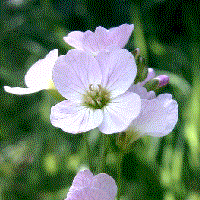 |
BRASSICACEAE (formerly CRUCIFERAE) - The Cabbage Family
This is a large family with many plants of major economic importance, including many familiar vegetables (Cabbage, Turnip), oil crops (Oil-seed Rape), ornamental plants (Wallflower, Alyssum), and weeds (Bittercress). They are found more or less all over the world, with most species occurring in the north temperate region and few in the southern hemisphere. They are mostly annual or perennial herbaceous plants, with one or two small shrubs or climbers. |
Characteristics of this Plant Family:
Leaves, Stem & Roots ~ The leaves are usually alternate up the stem. In species which are used as food crops, plants have been selected and bred to maximise the size of the part used - large, fleshy roots as in Turnips or Swedes, large leaves as in Cabbages, large flower buds as in Cauliflower and Broccoli.
Flowers ~ It is the flowers which give this plant family its original name of Cruciferae They are cruciform, made up of four petals in a cross shape. They are usually in clusters or heads, and the flowers are very often white or yellow, although they may be red, blue, orange, white, pink or mauve, particularly in species cultivated for ornament. Rarely (as in the Candytuft), there are two large and two small petals.
Recently, the international panel of botanists who rule on these things decided that all plant families ought to have the same ending (-aceae), and be named after a plant typical of the family, so the family is now called Brassicaceae after the type plant, Brassica (Cabbage).
Seeds ~ The seedpods of this plant family are also fairly easily identifiable. They are formed of two chambers joined by a thin membrane, which opens from the bottom. The seed pod may be round and flat, as in Honesty, or it may be long and thin, as in Wallflowers or Bitter Cress. The flat membrane often remains after the outer surface of the seed capsule has been shed.
(Click here for more information and examples of seedpods in this Family.)
Members of this Family usually have:
Four petalled flowers in a cross shape
Clusters of flowers
Papery membrane dividing a two-chambered seed capsule